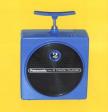Bye-Bye 8-Tracks




If you frequent garage sales, you've probably encountered 8-track stereo
tapes and players. About twice the size of a cassette, the 8-track was the
most popular medium for portable music players during the first half of the
70s.
Recently I discussed the revolution brought about by the development of the
high-fidelity cassette deck. Before these came about, the 8-track was just
about the only option you had if you wanted recorded music for your car or
portable player. Essentially, the 8-track cartridge held a continuous loop
of tape that wound around a single reel. Since stereo sound required two
tracks, the cartridge was able to contain four music programs recorded
side-by-side. You would put the 8-track into the player, and at first you
would hear the material on Track 1. When the recording reached the end of
its loop (after about 15-20 minutes), a small stretch of metal tape would
signal the player to switch to Track 2. And so on. You didn't have to flip
the cartridge over, and you could change tracks at the push of a button.
There was a fast-forward feature, but no rewind.
The fact that you could just slip the cartridge into its slot and forget it
made the 8-track popular with car owners. 8-track decks were also always
front-loading, so they would fit easily into a dashboard. Many home stereo
units sold at the time featured 8-track units, although everyone know that
LP records offered better sound quality (and made it easier to listen to
particular tracks). The 8-track was also not a very popular media for
recording purposes, one reason being that the gaps would appear in the
music whenever the recorder changed tracks. They also produced a great deal
of annoying tape hiss.
As cassette technology improved, more and more car stereos became equipped
with decks which would play them. Thus, the last market for the 8-track was
drying up. You started to see the tapes and decks quite often at thrift
shops and garage sales.

0 Comments:
Post a Comment
Subscribe to Post Comments [Atom]
<< Home